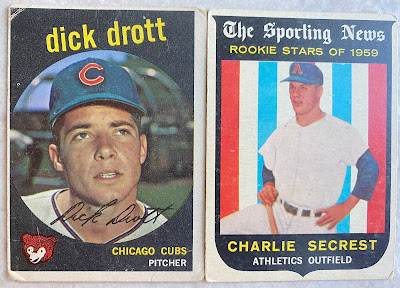I recently made my third time-travel card trade with Matt of Diamond Jesters - as always, it was an easy and enjoyable way for me to add a few vintage needs to my collection.
Dick Drott came up in 1957 as a 20-year-old flamethrower with Cubs, and won 15 games while striking out 170 batters and walking 129. He finished third in the Rookie of the year voting, but was 7-11 with a 5.43 ERA in 1958 and never found success again. He lingered on for five more years in the major leagues after that, but was atrocious, winning 5 games and losing 24 with a 5.34 ERA. He was 2-12 in his final season, with the Colt 45s.
Charlie Secrest never even made it to the majors. After he had hit 21 home runs with a .281 average, 33 doubles, 8 triples, 83 walks, and 99 runs batted for the Little Rock Travelers, Topps decided he was a rising star worthy of a card. They were wrong. His 21 home runs had been a fluke: he had never hit more than six home runs in a season before and never would again. He played 149 career games in AAA, most with the Portland Beavers, and was pretty mediocre.
He was a lefty, a small man, generously listed as 5'9", and after his first few seasons he was never much of a workhorse. But he was an effective pitcher, doing surprisingly well in rate stats: he led the league in K/9 in 1954, FIP in 1957, SO/W in 1957 and 1958, and WHIP and H/9 in 1959.
He was originally a left-handed shortstop in high-school, and put his fielding and batting abilities to good use in the major leagues. He won three straight gold gloves from 1958 to 1960, and had a solid .212 career batting average; he was used occasionally as both a pinch-hitter and pinch-runner up to 1958.
He was the winning pitcher of game seven in the 1960 World Series, aided by Bill Mazeroski's walk-off blast.
This is a picture of Roy Face, Maz, and Haddix from the 1960 World Series which I "borrowed" from Getty Images. As my grandpa wrote for the New York Daily News for decades I feel no compunction.
But all this talking about The Kitten has overshadowed another favorite of mine, Stu Miller.
Though I wish it were true that Stu Miller was blown off the pitching mound of Candlestick Park in the 1961 All-Star game, he was not. What really happened was that a blast of wind nearly knocked him over as he came set to face his first batter; he managed to keep his footing, but a balk was called on him. (Which is funny enough in itself.)
But when legend becomes fact, print the legend. As Stu Miller later said: "I wasn’t blown off that mound. I just waved a little. But I’ll always be the guy who was blown away, no matter what I say. There were 44,000 people in the park that day, but over the years I bet I’ve had at least 100,000 people tell me they saw me flying in the air. You’d think I’d been blown out into the Bay."
Stu was unimposing enough that the idea of him being blown off the mound in a game just felt right. He was small for a righty, 5'11" and 165 lb., and his nickname was "Little Stu." He wasn't exactly throwing smoke out there like Dick Drott, either; as Jim Murray put it, he had "three speeds of pitches - slow, slower, and reverse."
In a similar spirit, The Great American Baseball Card Flipping, Trading and Bubble Gum Book said:
"Stu Miller threw the ultimate banana ball. You had time for a Coke and a sandwich while waiting for his fastball to arrive. His pitches took so long to get up to the plate in fact that they occasionally even appeared to be going backward. Watching him from behind the third base dugout was guaranteed to make your palms itch and your seat squirm. You wanted to hightail it on down to the bat rack and have a rip at the little guy yourself. It was all an optical illusion of course. You couldn't have hit him and neither could very many real ball players. His pitches may have looked like custard pies on the way up to the plate but they had a tendency to disappear when they arrived."
The owner of the ultimate banana ball won the 1958 NL ERA title and came within 0.02 of repeating as ERA king in 1959, but finished 2nd to teammate Toothpick Sam Jones.
This was my first card from the 1969 Globe Imports set. I'll describe it as minimalist and call it a day. Nacht.




Major leaguers needs to use "banana ball" as a description again. ... Have always liked Haddix, I think the reasons are in your write-up
ReplyDeleteIt was a pleasure trading with you!
ReplyDeleteInteresting stuff! Was hoping to find a video of Miller and his banana ball... but the only thing that popped up was Savannah Bananas baseball videos. Couldn't find video of him getting blown off the mound either (but there is a radio broadcast).
ReplyDeleteDude, I love Harvey Haddix. 12 perfect innings. He's the man.
ReplyDeleteI guess we know where you got your writing talent from :)
ReplyDelete